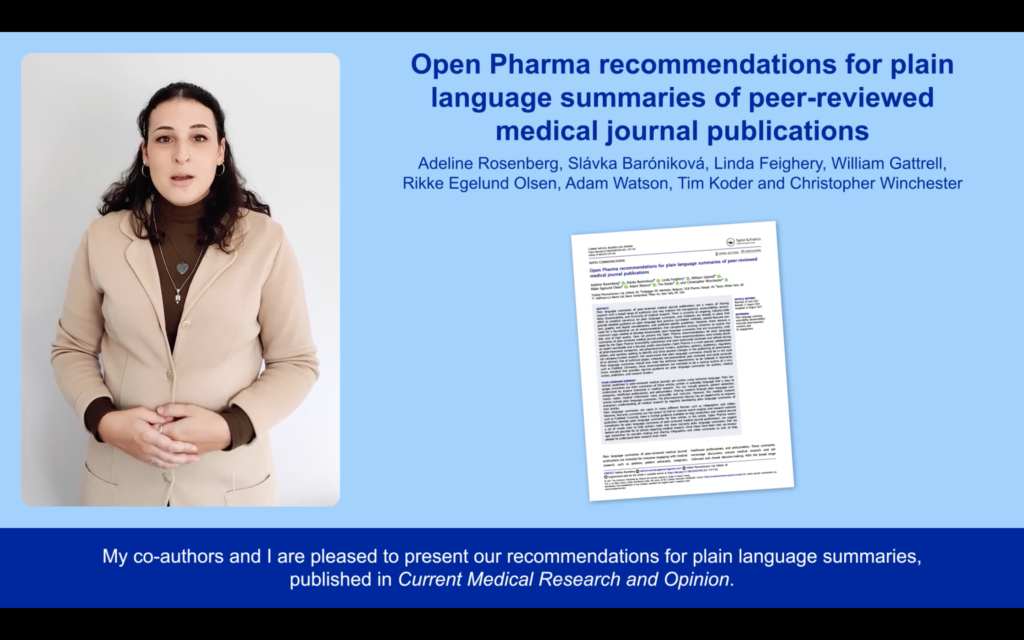Plain language summaries, or PLS, are a concept that has indelibly changed our world of medical publications, likely forever. And yet, we still seem a world away from having PLS integrated fully and consistently into publications practices. In fact, it has taken several years of head-scratching to even align on a definition for PLS for publications, versus patient lay summaries of clinical trials, layperson summaries, and so on.
However, we may have just taken a giant step closer to consensus. On 18 August 2021, Open Pharma collaborative published a ‘foundational’ set of recommendations for PLS for medical journal publications to ensure consistent standards of trustworthiness, credibility, and quality1. The recommendation overall is for a short, text-based summary to be developed which mirrors the scientific abstract and is made freely available to all potential readers. This is an encouraging development – a minimum set of standards to help ensure that PLS communicate clinical research in a straightforward way will undoubtedly benefit patients. But we should also take a moment to recognise that these are minimum standards, and challenge ourselves to ask what else PLS could achieve. How can we make sure PLS not only educate, but also play a role in improving patient experiences and outcomes?

Image credit: Open Pharma
We can trace the origins of PLS as an official concept back to 2015, when PFMD (Patient Focussed Medicines Development) worked to establish a patient engagement meta-framework focusing on early and clinical phases of medicines development2. This framework explored existing practices and defined key criteria for patient engagement including the role of patients in research and how to communicate results.
The next big step forward in the emergence of PLS came in 2017, when the European Commission introduced the ‘EU Clinical Trials Regulation’ requiring sponsors to provide trial summaries ‘in a format understandable to laypersons’3. This was followed in 2018, with the Commission providing a full outline of the content required in such lay summaries.
Yet, despite the new regulation mandating the provision of summaries, the floodgates didn’t really open. Lay summaries of clinical trials were developed as quickly and cheaply as possible, with no real thought given to their potential for patient education and engagement. Further guidance such as The European Federation of Pharmaceutical Industries and Associations (EFPIA) and The European Forum for Good Clinical Practices (EFGCP) ‘Roadmap to Good Lay Summary Practice’ have been introduced, while a long-awaited EU Clinical Trial Information System has seen many phases of development stall, with neither arguably really pushing the momentum for patient-friendly research summaries further along.
Unfortunately, terminology around PLS has remained confused. Indeed, a 2019 research piece found 9 separate expansions for the abbreviation “PLS,” including the primary concept that has come to dominate our world of medical publications — plain language summaries of medical research publications/presentations4. Additionally, the researchers found that public access at that point was inconsistent and so actual patient readership was low4. PLS of publications are distinct from lay summaries of clinical trials, though “PLS” may be ascribed to both, so being specific when referring to PLS is important — never assume others are of like mind!

But in many ways, despite publication innovations coming in the form of graphical summaries, videos and animations etc., this is where PLS have remained. While many journals and congresses have updated their platforms and instructions to allow or even encourage PLS of publications and presentations, others have not. Defining and reaching the ideal “PLS audience” remains a challenge. There is, however, cause for optimism in 2021. The Open Pharma guidance is welcome, robust and will answer a lot of questions about why and how PLS for medical journal publications should be developed. On the clinical trials registry front, we can also look forward to the EMA clinical trial reporting regulation coming into play, along with the Clinical Trial Information System (CTIS), which should further boost access and availability of lay summaries of clinical trials.
With improved guidance on development, then, coupled with improved accessibility via journals and the CTIS, perhaps it is time to consider how PLS (in whichever form, trial or publication summaries) can evolve further to benefit patients.
Could there be an option to integrate the Patient Activation Measure (PAM) within PLS, to help establish the elements involved in activation, including the knowledge, skills, beliefs, and behaviours that a patient needs to manage a chronic illness5? At Prime Patient, we believe so. By building on what makes an effective PLS – understandability, patient-focused content, accuracy – and incorporating elements of patient activation, we have developed an innovative new series of resources; Patient Voice Publications.
Patient Voice Publications amplify the patient voice by sharing stories of real-world experiences and hopes for the future, to not only bring the patient voice to pharma but also educate and support patients through personal, yet factual disease information and insights. By telling the patient story when pharma is meaningfully listening, we can drive better engagement and better outcomes for patients.
We look forward to launching the first Patient Voice Publications with over 10 rare disease patient groups at the RAREsummit21 on 07 October 2021.
Read more about our work in Patient Engagement here
Follow our Twitter for more insights and updates from the world of patient engagement
References:
- Rosenberg A, Baróniková S, Feighery L, Gattrell W, Egelund Olsen R, Watson A, Koder T & Winchester C. Open Pharma recommendations for plain language summaries of peer-reviewed medical journal publications, Current Medical Research and Opinion, 2021.
- Patient Focused Medicines Development (PFMD). Annual Report 2016. [Accessed online 16/09/21 via http://www.thesynergist.org/annual-report-2016/pfmd.php
- European Commission. Summaries of Clinical Trial Results for Laypersons: Recommendations of the expert group on clinical trials for the implementation of Regulation (EU) No 536/2014 on clinical trials on medicinal products for human use. Feb 2018. [Access online 16/09/21 via https://ec.europa.eu/health/sites/default/files/files/eudralex/vol-10/2017_01_26_summaries_of_ct_results_for_laypersons.pdf]
- FitzGibbon H, King K, Magee R, Piano C, Wilk C, Gaskarth M. Where are biomedical research plain-language summaries (PLS)? Poster presented at the International Society for Medical Publication Professionals (ISMPP) 2019 European Meeting, London, 2019. [Access online 16/09/21 via https://ismpp.memberclicks.net/assets/docs/Education/EuropeanMeeting/2019EM/Posters/20Poster.pdf]
- Hibbard JH, Stockard J, Mahoney ER, Tusler M. Development of the Patient Activation Measure (PAM): conceptualizing and measuring activation in patients and consumers. Health Serv Res. 2004;39(4 Pt 1):1005-1026.




